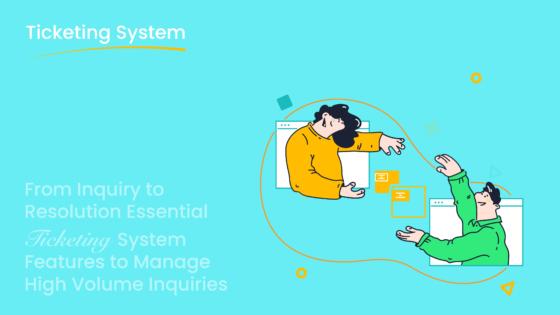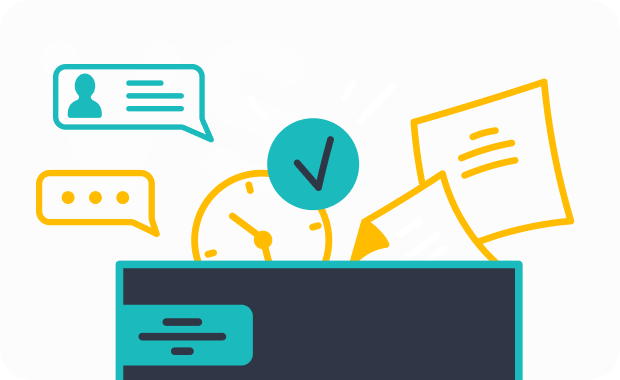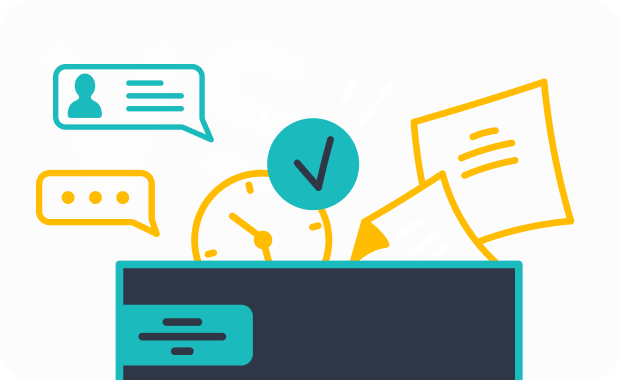Best Ticketing Systems for Small Business Support Teams

Running a small business comes with unique challenges, especially when it comes to customer support. You want to deliver fast, efficient service, but without the right tools, it’s tough to keep up. Did you know that 86% of small businesses see great customer service as their edge, yet only 33% feel they’re nailing it? That’s where ticketing systems step in. They help you organize support requests, speed up responses, and keep your team on track. Plus, with tools like real-time data and predictive analytics, you can personalize customer experiences and build trust. Systems like Sobot even unify communication channels, making them the best customer service ticketing system for unified communication.
What Are Ticketing Systems and Why Do Small Businesses Need Them?
Definition of Ticketing Systems
Ticketing systems are tools that help you manage customer inquiries efficiently. Think of them as a digital assistant that organizes all your customer support requests into one place. Whether a customer reaches out via email, chat, or voicemail, the system creates a "ticket" for each issue. These tickets track the progress of every request, ensuring nothing slips through the cracks. For small businesses, this means you can stay on top of customer needs without feeling overwhelmed.
Benefits of Ticketing Systems for Small Business Support Teams
Using ticketing systems can transform how your small business handles customer support. Here’s how:
- Unified inbox for omnichannel support: All customer messages land in one dashboard, making it easier for you to respond quickly.
- Automated ticket routing: The system assigns tickets to the right team member, saving time and avoiding confusion.
- SLA management: You can set response deadlines, ensuring urgent issues get resolved fast.
- Self-service options: Customers can find answers on their own, reducing the number of tickets your team has to handle.
- Collaboration tools: Your team can work together seamlessly, speeding up problem resolution.
These features not only improve efficiency but also boost customer satisfaction. For example, Camping World saw a 33% jump in agent efficiency after implementing AI-powered tools.
Challenges Solved by Ticketing Systems
Small businesses often struggle with managing growing customer demands. Ticketing systems solve this by:
- Reducing workload: Automations handle repetitive tasks, freeing up your team for complex issues.
- Improving scalability: As your business grows, the system adapts to handle more inquiries without chaos.
- Enhancing professionalism: A well-organized helpdesk software makes your business look polished and reliable.
For instance, a retail company cut ticket volume by 50% using AI-powered self-service. These systems also create a knowledge repository, helping train new employees and maintain consistent service quality.
Key Features to Look for in the Best Help Desk Software
When choosing the best help desk software for your business, you’ll want to focus on features that make your team’s job easier and your customers happier. Let’s dive into the must-haves.
User-Friendly Interface
A simple, intuitive interface is non-negotiable. You don’t want your team wasting time figuring out how to use the software. The best help desk software should feel like second nature, even for new users. Look for clean layouts, easy navigation, and quick access to essential tools. A user-friendly design ensures your team can focus on solving customer issues instead of wrestling with the system.
Automation and Workflow Management
Automation tools are game-changers. They handle repetitive tasks like ticket sorting, routing, and even sending follow-ups. This speeds up response times and ensures no ticket gets overlooked. With automation features, you can also set up workflows that match your team’s processes. For example, you can prioritize urgent tickets or assign specific issues to specialized agents. These tools save time and boost productivity.
Multi-Channel Support for Customer Service Help Desk
Your customers reach out through different channels—email, chat, social media, and more. The best help desk software brings all these messages into one place. This unified approach ensures you never miss a query, no matter where it comes from. Plus, it makes it easier for your team to provide consistent, high-quality support across all platforms.
Reporting and Analytics for Performance Insights
Data is your secret weapon. The right help desk software gives you detailed reports on key metrics like response times, ticket resolution rates, and customer satisfaction. These insights help you identify what’s working and where you can improve. For example, reporting tools can show you if certain issues take longer to resolve, so you can adjust your processes accordingly.
Here’s a quick look at some key features and their benefits:
| Feature | Benefit |
|---|---|
| Automation | Automates ticket sorting and routing, ensuring faster resolution and adherence to SLAs. |
| Asset Management | Centralizes IT asset data, enabling quicker issue resolution with all necessary information. |
| Reporting | Provides holistic views of KPIs, aiding in smarter decision-making for support teams. |
| Self-Service Capabilities | Empowers users to resolve common issues independently, reducing the workload on support staff. |
Scalability and Integration with Other Tools
As your business grows, your help desk software should grow with you. Scalability ensures the system can handle more tickets and users without breaking a sweat. Integration is just as important. The best help desk software connects seamlessly with tools you already use, like CRM platforms or e-commerce systems. This creates a smooth workflow and keeps all your data in one place.
By focusing on these features, you’ll find help desk software that not only meets your current needs but also supports your future growth. And with AI-driven support becoming more common, you can expect even smarter solutions to enhance your customer service.
Top-Rated Ticketing Systems for Small Businesses in 2025

Choosing the right ticketing system can make or break your customer support strategy. Here’s a look at the top-rated options for 2025, each excelling in unique areas to meet your business needs.
Zendesk: Best for Multi-Channel Support
Zendesk stands out for its ability to handle customer interactions across multiple channels seamlessly. Whether it’s email, live chat, or phone support, Zendesk ensures your team can manage everything from one platform.
| Evidence Type | Statistic | Source |
|---|---|---|
| Customer Satisfaction Rating | Phone support: 91%, Live chat: 85% | Zendesk |
| Customer Interaction Preference | 69% of customers prefer bots for simple issues | Zendesk |
| Expectation for Conversational Care | Over 70% expect conversational care experiences | Zendesk |
| Preference for Digital Engagement | 57% prefer digital channels | Salesforce |
This system is ideal if your customers expect conversational care and prefer digital engagement. Its robust analytics also help you track performance and improve customer satisfaction.
Freshdesk: Best for Automation and Ease of Use
Freshdesk simplifies customer support with its automation features and user-friendly interface. It’s perfect for small businesses looking to save time and reduce manual effort.
- Key Features:
- AI-powered bots for quick self-service.
- Automated ticket generation to categorize and assign tickets instantly.
- Follow-up management to ensure no issue is left unresolved.
- Priority filtering to focus on urgent queries.
| Feature | Benefit |
|---|---|
| Automation Services | Simplifies workflows and boosts customer satisfaction. |
| Automated Ticket Generation | Reduces manual tracking efforts by categorizing tickets automatically. |
| Follow-Up Management | Ensures timely resolution by prompting teams for follow-ups. |
| Scenario-Based Processing | Automates responses for recurring issues based on historical data. |
Freshdesk’s unified workspace makes it easy to manage, prioritize, and resolve tickets efficiently. It’s a wallet-friendly option, with a free plan available for small businesses.
Zoho Desk: Best for Streamlining Customer Service Operations
Zoho Desk excels in improving operational efficiency. It’s designed to help your team resolve issues faster while keeping customers happy.
| Metric | Improvement |
|---|---|
| First Contact Resolution | 15% increase |
| Response Time | 50% faster |
| Customer Satisfaction Score (CSAT) | 14% increase |
| Customer Churn Rate | 48% reduction |

Zoho Desk’s analytics and automation tools make it a great choice for businesses aiming to streamline their customer service operations. Its ability to reduce churn and improve response times is a game-changer.
Help Scout: Best for Email-Based Customer Support
If your business relies heavily on email for customer communication, Help Scout is a fantastic option. Its straightforward ticketing system and collaborative inbox make managing multiple mailboxes a breeze.
- What Users Love:
- A user-friendly interface that’s less confusing than competitors.
- Exceptional customer service that keeps users loyal despite occasional issues.
- Reporting tools to measure customer satisfaction and identify areas for improvement.
- Help Scout’s customer satisfaction ratings provide valuable feedback.
- The collaborative inbox enhances team communication and ensures consistency.
- Analytics tools help you track performance and refine your support strategy.
Help Scout is perfect for small teams that want a simple yet effective email-based ticketing system.

Sobot Ticketing System: Best Customer Service Ticketing System for Unified Communication
Sobot takes the crown as the best customer service ticketing system for unified communication. It’s designed to bring all your customer interactions—email, voicemail, and chat—into one platform. This unified approach ensures your team can respond quickly and consistently, no matter the channel.
- Why Sobot Stands Out:
- Automation: Automatically routes tickets to the right agents, saving time and reducing errors.
- SLA Management: Set response and resolution times to meet customer expectations.
- Multilingual Support: Serve customers in their preferred language, enhancing satisfaction.
- Comprehensive Analytics: Monitor performance and identify areas for improvement.
Sobot’s intelligent tools, like custom trigger rules and SLA reminders, make it a powerful solution for small businesses. It also integrates seamlessly with e-commerce platforms like Shopify, making it a versatile choice.
Customer Success Story: OPPO, a global smart device leader, used Sobot’s ticketing system to handle a surge in customer inquiries during peak shopping periods. By automating repetitive tasks and integrating global customer channels, OPPO achieved an 83% chatbot resolution rate and a 94% positive feedback rate.
With Sobot, you’re not just managing tickets—you’re building stronger customer relationships. Its focus on innovation and efficiency makes it a must-have for small businesses aiming to scale their support operations.
How to Choose the Right Ticketing System for Your Business
Choosing the right ticketing system can feel overwhelming, but breaking it down into key steps makes it manageable. Here’s how you can find the perfect fit for your business.
Assessing Your Business Needs and Goals
Start by understanding what your business truly needs. Think about the challenges your team faces daily. Are you struggling to keep track of customer inquiries? Do you need faster response times? Or maybe you want to improve collaboration within your team? Identifying these pain points helps you focus on solutions that address them directly.
Next, align your goals with the features you’re looking for. For example, if improving efficiency is a priority, look for automation tools that handle repetitive tasks. If customer satisfaction is your main goal, consider systems with SLA management and self-service options. Remember, the right ticketing system should solve your current problems and support your long-term objectives.
Tip: Involve your team in this process. They’re the ones using the system daily, so their input is invaluable.
Comparing Features, Pricing, and User Reviews
Once you know your needs, it’s time to compare options. Look at the features each system offers and how they align with your goals. For instance, some systems excel in automation, while others shine in multi-channel support. Create a checklist of must-have features to guide your decision.
Pricing is another critical factor. Many ticketing systems offer tiered plans, so you can start small and scale up as your business grows. Don’t just focus on the cost—consider the value you’re getting. A slightly more expensive system with better features might save you money in the long run by improving efficiency.
User reviews are a goldmine of information. They give you real-world insights into how the system performs. Look for reviews that mention ease of use, customer support, and reliability. A quick help desk software comparison can reveal which systems consistently deliver on their promises.
| Metric/Criteria | Type | Description |
|---|---|---|
| Quality Metrics | Quality | Measure the error rate associated with configuration changes. |
| Knowledge Base Utilization | Efficiency | Measure the frequency of knowledge base usage. |
| Agent Training Scores | Quality | Collect scores from agent training assessments. |
| Ticket Reopens | Quality | Monitor reopened tickets due to insufficient knowledge. |
| Customer Satisfaction Score (CSAT) | Customer Experience | Gauge customer satisfaction with the accuracy of the knowledge provided. |
| Resolution Time | Efficiency | The speed at which tickets are closed reflects your process efficiency. |
| Average Handling Time | Efficiency | This metric tracks the time agents spend on each ticket. |
| Escalation Rate | Efficiency | A higher escalation rate could indicate process bottlenecks or inadequate agent training. |
| Ticket Backlog | Efficiency | A backlog indicates inefficiency and can lead to customer frustration. |
| Self-Service Adoption Rate | Efficiency | Encouraging self-service reduces the load on agents, boosting efficiency. |
Considering Scalability and Future Growth
Your business won’t stay the same forever, and neither should your ticketing system. Scalability is crucial. As your customer base grows, you’ll need a system that can handle more tickets, users, and channels without breaking down.
Cloud-based solutions are a great choice for scalability. They let you add features or users as needed, without the hassle of upgrading hardware. This flexibility ensures your system grows with you, keeping your operations smooth and efficient.
The growing demand for IT ticketing systems reflects their importance for small businesses. As companies expand, managing IT assets and services becomes more complex. A centralized platform simplifies this process, improving service delivery and maintaining competitiveness. Investing in a scalable system now saves you from headaches later.
Evaluating Integration Capabilities with Existing Tools
Your ticketing system shouldn’t work in isolation. It needs to integrate seamlessly with the tools you already use, like CRM platforms, e-commerce systems, or communication apps. This ensures a smooth workflow and eliminates the need for manual data transfers.
When evaluating integration capabilities, consider these points:
- Check if the system supports native, third-party, or custom integrations.
- Ensure compatibility with your existing tools.
- Analyze how the integration will impact your workflows.
- Measure the integration’s performance after implementation to ensure it meets your expectations.
A well-integrated system not only saves time but also enhances productivity. For example, connecting your ticketing system with a CRM platform gives your team instant access to customer data, enabling faster and more personalized support.
Note: Integration isn’t just about convenience. It’s about creating a unified ecosystem that supports your business goals.
Tips for Implementing and Optimizing Your Ticketing System

Planning and Preparing for Implementation
Getting your ticketing system up and running starts with a solid plan. First, identify the specific challenges your team faces. Are you struggling with response times or juggling multiple communication channels? Once you know your pain points, choose a system that addresses them. For example, a unified ticketing platform can centralize customer communication, making it easier to track and respond to inquiries.
Next, map out your workflows. Think about how tickets should move through your system. Automating these workflows can save time and ensure urgent issues get the attention they need. Don’t forget to involve your team in this process. Their input will help you design workflows that actually work in real-life scenarios.
Finally, test the system before going live. Run a pilot program with a small group of users to identify any issues. This step ensures a smoother rollout and minimizes disruptions.
Training Your Support Team for Effective Use
Your ticketing system is only as good as the people using it. Training your team is crucial. Start by teaching them how to handle queries across different channels. This skill ensures quicker and more accurate resolutions. A well-organized knowledge base can also empower your team. It gives them instant access to information, speeding up the resolution process.
Encourage your team to embrace automation. Show them how automated workflows can reduce their workload and improve efficiency. Foster a culture of continuous learning by encouraging knowledge sharing. When team members share tips and tricks, everyone benefits.
Monitoring Performance and Gathering Feedback
Once your system is live, keep an eye on its performance. Use ticket tracking and reporting tools to monitor key metrics like response times and resolution rates. These insights can highlight areas for improvement. For example, if certain tickets take too long to resolve, you might need to adjust your workflows.
Don’t just rely on data—ask your customers for feedback. Their insights can help you refine your processes and improve satisfaction. Regularly review this feedback to identify trends and make necessary adjustments.
Regular Updates and Optimization for Continuous Improvement
Your ticketing system isn’t a “set it and forget it” tool. Regular updates keep it running smoothly and ensure it meets your evolving needs. Review your workflows periodically to see if they still align with your goals. If not, tweak them.
Stay on top of new features and updates from your provider. These enhancements can offer new ways to improve efficiency. For example, adding self-service options can reduce ticket volume and free up your team for more complex issues. Continuous optimization ensures your system grows with your business.
Tip: Make use of ticket tagging to organize tickets effectively. It helps your team prioritize and manage issues more efficiently.
Choosing the right ticketing system can transform your customer support. It helps you respond faster, track performance, and keep customers happy. Systems like Sobot unify communication and boost efficiency, making them a smart choice for small businesses.
Here’s how the right system improves outcomes:
| Feature | Impact on Support Outcomes |
|---|---|
| Performance Tracking | Helps you monitor and improve support processes. |
| Customer Satisfaction Measurement | Shows how well your service meets customer needs. |
| Trend Analysis | Identifies patterns to refine strategies. |
Ready to take the next step? Start a free trial or consult vendors to find the perfect fit for your business.
FAQ
What is the main purpose of a ticketing system?
A ticketing system helps you organize and manage customer inquiries. It ensures no request gets missed and improves response times, making your support team more efficient.
Can a ticketing system grow with my business?
Yes! Many systems, like Sobot, are scalable. They adapt to handle more tickets, users, and channels as your business expands.
💡 Tip: Choose a cloud-based system for easy scalability and flexibility.
How does automation improve customer support?
Automation speeds up repetitive tasks like ticket routing and follow-ups. It reduces manual work, allowing your team to focus on solving complex customer issues.
🚀 Pro Tip: Use automation to prioritize urgent tickets and meet SLAs effortlessly.
See Also
Best Live Chat Solutions for Small Enterprises in 2024
Enhance SaaS Customer Service Using Live Chat Techniques
Comparing Shopify and Rivals: Best Live Chat Tools